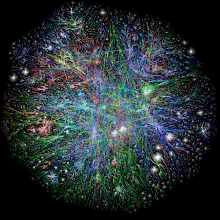Bruns further comments on open source software as produsage, identifiying four key principles:
- open participation, communal evaluation
- fluid heterarchy, ad hoc meritocracy
- unfinished artefacts, continuing process
- common property, individual rewards
From this we can see that open source production as an example of community produsage is social and holds little structure, with all content being open for interpretation, editing, or completely altering.
Alternatively, commercial production holds very different principles. Production often complies to a rigid, closed structure with defined goals, coming to a very final conclusion. Participation in commercial production is only from those directly involved in the project, and owned solely by a certain group of people. Quite simply, as open source software and community produsage are very 'open' in nature, commercial production is very 'closed'.
My two previous posts expand on this thought, and discuss the ways in which the community produsage and commercial production are becoming interlinked with open source software and Web 2.0.
References
Bruns, Axel. 2008. Open Source Software Development: Probabilistic Eyeballs. In Blogs, Wikipedia, Second Life, and Beyond: From Production to Produsage, ed. A. Bruns, 37-68. New York: Peter Lang.


No comments:
Post a Comment